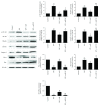miR-146a Attenuates Sepsis-Induced Myocardial Dysfunction by Suppressing IRAK1 and TRAF6 via Targeting ErbB4 Expression
- PMID: 30224945
- PMCID: PMC6129849
- DOI: 10.1155/2018/7163057
miR-146a Attenuates Sepsis-Induced Myocardial Dysfunction by Suppressing IRAK1 and TRAF6 via Targeting ErbB4 Expression
Abstract
Myocardial dysfunction is a major manifestation of sepsis and closely associated with the increased mortality. MicroRNA-146 is one of the most important microRNAs identified as a potent negative regulator in innate immune and inflammatory responses induced by lipopolysaccharide (LPS). We aimed to identify the role and potential regulatory mechanism of miR-146a in sepsis-induced cardiac dysfunction with the induction of ErbB4 signaling. H9C2 cells were treated with LPS to induce sepsis, and miR-146a overexpression significantly increased the cell viability, reduced the apoptosis and ROS level, and attenuated the release of proinflammatory cytokines including TNF-α and IL-1β. Levels of ErbB4, p-NF-κB, NF-κB, TRAF6, IRAK1, caspase 3, Bcl-2, and Bax were measured by Western blot. The overexpression of miR-146a significantly increased the ErbB4 expression, decreased the expression of TRAF6, IRAK1, caspase 3, and the phosphorylation level of NF-κB, and also increased the Bcl-2/Bax ratio, suggesting the inhibition of inflammation and apoptosis. The protective effects were all abolished by the use of siErbB4. In conclusion, our results demonstrated that the overexpression of miR-146a mitigates myocardial injury by negatively regulating NF-κB activation and inflammatory cytokine production via targeting ErbB4 in LPS-induced sepsis.
Figures









References
MeSH terms
Substances
LinkOut - more resources
Full Text Sources
Other Literature Sources
Medical
Research Materials

